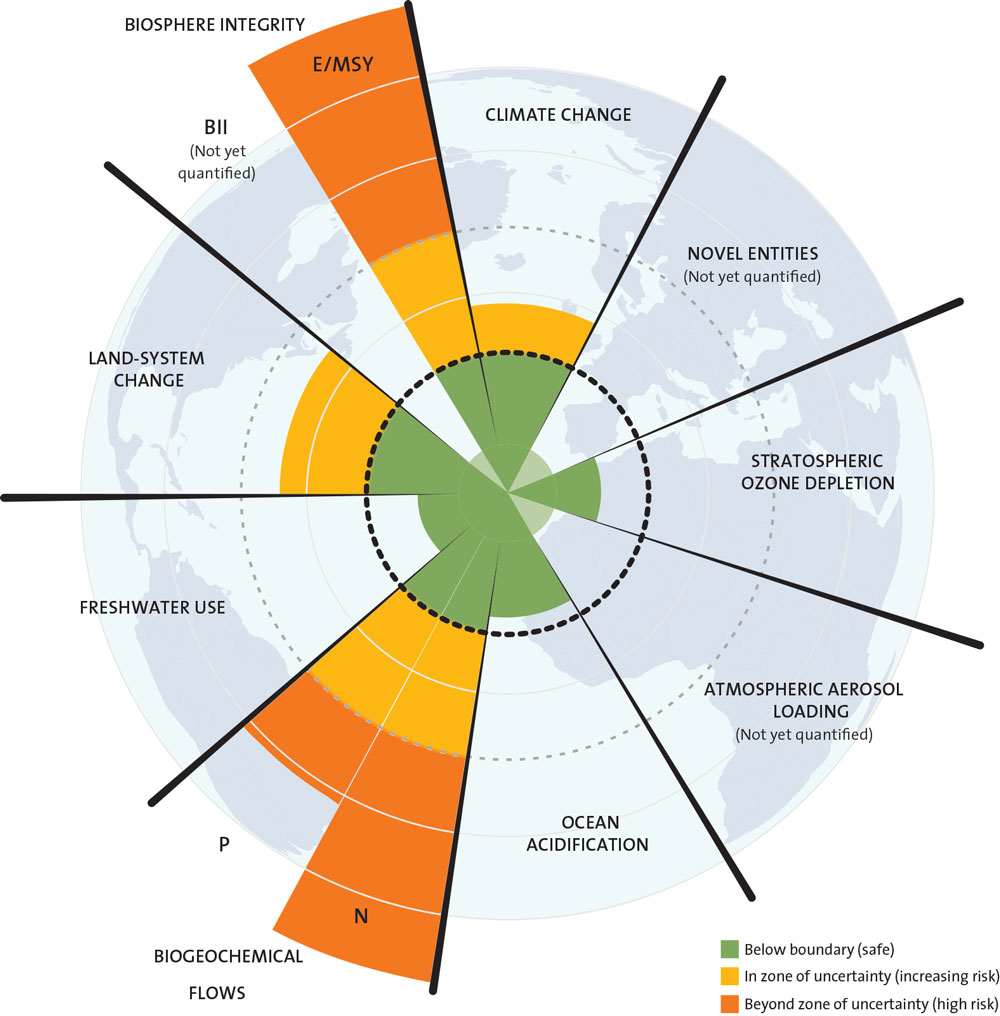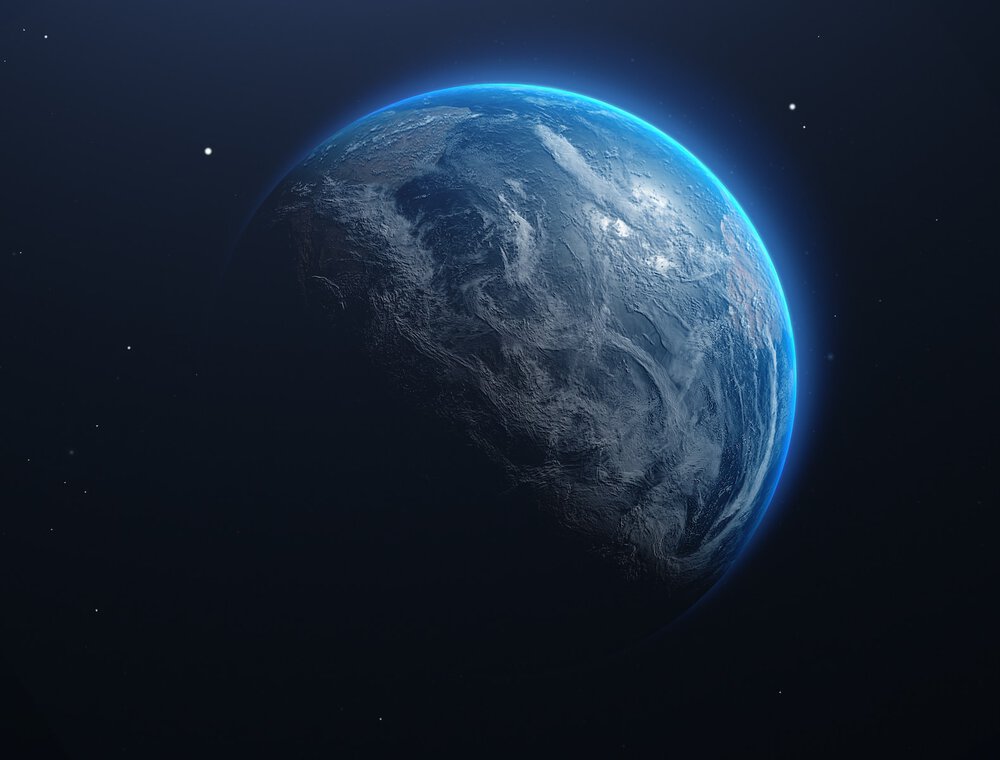As the stewards of our shared home, we stand on the brink of an unprecedented era where our collective actions will decide the fate of planet Earth. Understanding the ‘six planetary boundaries’ concept has never been more critical. These are the six vital parameters that keep our planet in a healthy state conducive to human life. Each boundary is a line in the cosmic sand, a checkpoint warning us of the perilous consequences of trespassing. In an increasingly globalized world, these boundaries remind us that our planet’s resources are not infinite but rather finely balanced systems that are now under siege by our exponential growth.
A planetary boundary is a critical limit of biophysical conditions within which human life can thrive on Earth, and crossing this limit risks triggering drastic environmental changes.
The six planetary boundaries symbolize our understanding of Earth’s fragility and the imperative for sustainable coexistence. We must accept these boundaries as we navigate our future labyrinth. Failure to do so may push our planet into an unstable state, where life as we know it could be seriously threatened. As we continue to peer over the precipice of our uncertain future, knowing these boundaries will be a vital compass guiding us towards a sustainable tomorrow. Embrace this understanding and act upon it – our future depends on it.
Why this is so important?
The planetary boundaries concept is a compelling alarm bell that cannot be ignored. It offers a scientific approach to gauging the health of our planet and the consequences of our actions. This framework bears the stark reality that Earth’s resources are not boundless, and each boundary crossed risks irreparable damage to our planet’s delicate balance.
Understanding these boundaries is integral to fostering a sustainable future. Every crossed boundary diminishes Earth’s resilience, pushing us further into the danger zone where abrupt and irreversible environmental changes could occur. It is akin to driving at high speed towards a cliff edge, blindfolded; with each boundary crossed, we edge closer to the precipice.
Planetary boundaries remind us that our actions, whether as individuals, communities, or nations, are not isolated. They ripple through interconnected global systems, affecting Earth’s stability and collective survival. They urge us to reassess our strategies and adopt sustainable practices that respect these boundaries.
In essence, the concept of planetary boundaries underscores the urgency to rethink our relationship with our planet. It’s a call to action, a call for responsibility, and a call for transformation. This concept must be ingrained in our consciousness as we strive for a sustainable future that ensures the continuity of human life on Earth.
What are the 9 Planetary Boundaries?
The concept of planetary boundaries was proposed by a group of 28 internationally renowned scientists led by Johan Rockström from the Stockholm Resilience Centre and Will Steffen from the Australian National University in 2009. This novel framework outlined nine ‘boundaries’ within which humanity can continue developing and thriving for future generations. Cross these lines, and we risk destabilizing the holistic environment that sustains life on Earth.

Climate Change: Perhaps the most widely understood boundary, climate change refers to the increase in the Earth’s average temperature due to anthropogenic activities, primarily the burning of fossil fuels and deforestation. Exceeding this boundary leads to severe weather events, rising sea levels, and disruption of ecological systems that can drastically alter the Earth’s state.
Biodiversity Loss: Biodiversity, the variety of life on Earth, is essential for maintaining the health of ecosystems. Crossing this boundary could disrupt critical functions such as pollination, oxygen production, and decomposition, potentially leading to ecosystem collapse.
Biogeochemical Flows: Cycling nitrogen and phosphorus through the Earth’s system is a vital process for life. However, human activities like industrial farming disrupt these cycles, causing issues like water pollution and ocean dead zones.
Ocean Acidification: Oceans absorb about a quarter of human-caused carbon dioxide emissions, increasing acidity. This acidification severely threatens marine ecosystems, particularly coral reefs and shellfish, which are vital for maintaining marine biodiversity.
Land-Use Change: Humans increasingly transform Earth’s landscapes for agriculture and urban development. This boundary concerns the amount of land converted from its natural state, impacting biodiversity and disrupting ecosystems, particularly forests, which are significant carbon sinks.
Freshwater Use: Freshwater is a finite resource, and its overuse threatens the overall availability and distribution of water. Exceeding this limit can lead to water shortages and conflict, impacting human societies and ecosystems.
Atmospheric Aerosol Loading: Aerosols are tiny particles suspended in the atmosphere that can impact climate and living organisms. Anthropogenic activities contribute significantly to aerosol loading, influencing climate systems and human health.
Ozone Depletion: The Earth’s ozone layer protects life from harmful ultraviolet radiation. Despite successful international efforts to reduce ozone-depleting substances, we must remain vigilant not to cross this boundary to prevent adverse effects on human health and ecosystems.
Introduction of Novel Entities: This boundary refers to new substances, new forms of existing substances, and modified life forms that have the potential for unwanted geophysical and biological effects. Synthetic pollutants, radioactive materials, nanomaterials, and microplastics can have pervasive impacts on ecosystems and human health.
In a world pushing its planetary boundaries, understanding these nine limits is critical for balancing our aspirations for development with the sustainability of our planet. They serve as crucial ‘guardrails’ for human activity, urging us towards a harmonious relationship with Earth.

Humankind just crossed the 6th planetary boundary.
In a recent revelation that underscores the urgency of environmental conservation, we crossed another planetary boundary in 2022, this time concerning the freshwater cycle. The research, jointly carried out by the Potsdam Institute and the Stockholm Resilience Center, incorporated a new factor into their assessment – “green water,” the water that is accessible to plants.
Despite the current media focus on high-profile events such as Elon Musk’s acquisition of Twitter, the quieter but more alarming news is that we’ve once again transgressed a crucial planetary limit. The implications are nothing short of critical, impacting the stability of the global ecosystems integral to our survival as a species.
The freshwater cycle, the sixth planetary boundary, is a complex, interdependent process that circulates water throughout the Earth’s ecosystems. From precipitation falling on land to the rivers carrying it into the oceans, from evaporation back into the atmosphere, and finally to precipitation again – this cycle is crucial to life on our planet. The lifeline facilitates essential functions, from driving our climate to supporting biodiversity to providing water necessary for human consumption and agriculture. The freshwater cycle boundary refers to the total amount of freshwater available and the rate at which it cycles between the Earth’s atmosphere, land, and oceans.

In essence, the freshwater boundary is defined by two key components: water usage and water flow. Excessive water usage, especially for agriculture, can severely drop water levels in rivers and underground aquifers. Disruption of water flow can occur from the construction of dams, which alter the natural flow of rivers, impacting both wildlife and people downstream.
Unfortunately, recent studies have shown we’ve crossed this critical planetary boundary. In 2022, a study conducted by the Potsdam Institute and the Stockholm Resilience Center announced that we had crossed the freshwater boundary mainly due to human overconsumption and mismanagement. A key factor was “green water” in their assessment, representing water available to plants, crucial for our global food supply.
The crossing of this boundary has grave implications. It threatens water security, impacting both humans and wildlife. For people, it could lead to water shortages, affect food production, and even spark conflicts over water resources. For wildlife, changes in the freshwater cycle could lead to the loss of aquatic habitats, declines in fish populations, and widespread loss of biodiversity.
The freshwater cycle is also closely linked to other planetary boundaries, such as climate and land-use changes. As climate change accelerates, it alters precipitation and evaporation patterns, disrupting the freshwater cycle. Simultaneously, land-use changes can affect the capacity of landscapes to absorb and store water, exacerbating water shortages.
To Conclude,
Despite the ominous specter of crossing planetary boundaries, we are far from helpless. The very knowledge of these boundaries equips us with the power to reverse course, presenting a unique opportunity to script a narrative of resilience and recovery. Yes, the stakes are high, and yes, the challenges are monumental, but human innovation, collective action, and willpower are formidable forces.
Firstly, acknowledging the problem is the vital step towards solution. Understanding the planetary boundaries illuminates our environmental impact, helping us to reassess and restructure our behaviors at individual, communal, and global scales. Each small action, every conscious decision, contributes to a broader shift towards sustainability.
Technological innovation can also offer transformative solutions. From renewable energy technologies mitigating climate change, to advanced recycling methods reducing pollution, and precision agriculture minimizing water and nutrient usage – our technological prowess can be harnessed to restore and conserve our planet.
Furthermore, policy and regulatory changes are instrumental in driving systemic transformation. Governments and international organizations must recognize the gravity of crossing planetary boundaries and enact legislation promoting sustainable practices. Herein lies the potential for progressive policies that can fundamentally shift our relationship with the planet from one of exploitation to stewardship.
Lastly, education is key. By raising awareness about the nine planetary boundaries, we cultivate an informed global community capable of making sustainable choices. Knowledge is power, and widespread understanding of these boundaries can spur collective action and instigate significant change.
José Amorim
Information sourced by the author for luxuryactivist.com. All content is copyrighted with no reproduction rights available. Images are for illustration purposes only.
